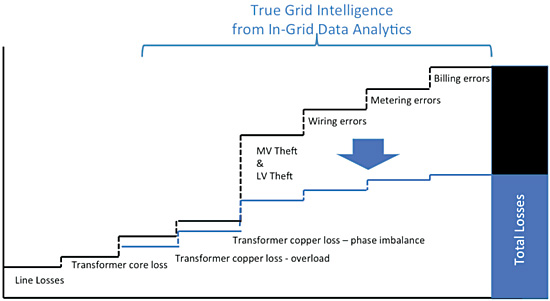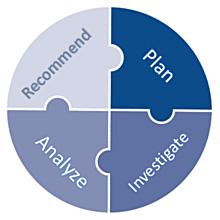Introduction
Electricity distribution network operators face unique security challenges in that they cannot possibly track every ‘leak’ in their distribution grids using smart meters alone. With yearly losses estimated to exceed US$200 billion worldwide and growing, network operators are under pressure to reduce risk and improve safety, increase efficiency and improve financial performance. Awesense Inc has introduced the True Grid Intelligence (TGI) platform to address this problem.
The approach acknowledges the fact that there is rarely enough monitoring in place to pinpoint overloaded or imbalanced transformers, illegal bypasses and metering errors. It also recognizes that it is not practical to build a security perimeter around thousands of miles of distribution lines, nor to monitor hundreds of thousands of distribution transformers. With the opportunities for power theft so widespread and easily accomplished, but difficult to detect, it’s little surprise that losses due to theft, imbalance, overloads and errors can go unchecked for years.

TGI can identify grid losses stemming from both technical and non-technical sources
The platform offers a new approach that gives utilities the in-grid data analytics they need to understand real grid operating conditions and identify a complete range of losses between billing points and substations.
Big data analysis can leave costly information gaps
Data analytics have been used for many years to battle fraud and abuse in the insurance and finance industries, and more recently in the IT industry to address the mounting need for cyber security. In the last few years, a few major analytics vendors have applied these big data analytics techniques to massive volumes of data generated by the widespread deployment of smart meters; this is called meter data analytics, (MDA).
When an MDA system generates an alert, that alert needs to be investigated – and MDA systems can generates hundreds or even thousands of alerts every month. How can a utility efficiently investigate so many alerts coming from a vast service area? Compared to the challenge of investigating losses (due to fraud and abuse and errors) in a closed system like a data center used by a credit card company, for example, investigating losses on an open system with thousands of kilometers of distribution lines and millions of widely dispersed billing meters is extremely daunting. Although a good starting point, big data analytics cannot tackle this problem alone.
TGI addresses the challenge by providing a framework to prioritize the highest risk areas of the grid, to carry out investigations in an effective and systematic manner, and to document the facts of an investigation for legal or audit purposes.
Comparison to other industries is useful: an insurance provider might identify fraud through unusual claim patterns, and send a field investigator to confirm whether or not the claims are legitimate. A finance company might identify fraud through unusual credit card purchase patterns and call the cardholder by phone to see if the purchases were legitimate. These investigations are relatively easy to carry out quickly and cost effectively.
In an electrical distribution network, the MDA system may generate an alert if a subscriber’s consumption pattern has suddenly dropped off, for example, or if the voltage on one house is lower than his neighbors. These techniques can be effective in finding the most blatant thieves. The field investigator now has to prove that these alerts are the result of fraudulent behavior (theft by diversion) rather than legitimate changes in usage. Smart meters and MDA, according to an EPRI study,1 can identify about 30 percent of theft – but they do not address the complex requirements of investigations of fraud and abuse of the electrical grid.
Furthermore, MDA cannot find losses if the meter was installed incorrectly (intentionally or inadvertently), if there is a wiring or a billing error, if there is no meter installed, or if the diversion is near the transformer or on the MV line. MDA is also unable to identify inefficient transformers (severe phase imbalance) or heavily loaded transformers caused by unknown loads.
Utilities need more than traditional modeling
Utilities want to leverage their investment in smart meters and analytics. All of the alerts and alarms and usage trends can help identify areas in the grid that deserve further attention. Engineers and customer service personnel can use this data to create load models and try to predict consumption trends.
But modeling is only as good as the data it uses. No model based only on meter data can identify the severity and location of non-technical losses such as illegal connections, meter wiring errors, meter setting errors, and billing multiplier errors. Without the ability to gather in-grid data (which is downstream from the substation and upstream from the billing meter) a distribution grid operator is blind to the real operating conditions on their distribution lines.
Some vendors have recently introduced sensors and meters that can be connected directly to medium voltage (MV) lines and on the low voltage (LV) side of distribution transformers. These devices provide additional data streams that can dramatically improve the awareness of line operating conditions – if enough of them are installed.
Rarely can a distribution network operator afford to place enough permanent line or transformer meters throughout the network to pinpoint fraud, abuse and other losses in the grid. Furthermore, even if the area of interest can be narrowed down to a small neighborhood there will always be a need to carry out a field investigation to identify the cause. TGI addresses this need.
True Grid Intelligence based on in-grid data
This technology offers an efficient and effective solution for establishing what is really happening on an electrical distribution grid. With it, the highest-risk areas within the grid are sampled to collect in-grid data over a relatively short period of time – typically one week – taking a ‘snapshot’ of the actual operating conditions in those parts of the grid.
With this in-grid data, the network operator can identify the majority of losses, and introduce preventive measures as appropriate. This type of in-grid data is cost-effective to obtain and can easily be compared against probable operating parameters in order to rapidly confirm if a particular grid segment is compromised, or in need of extra investigation.
The platform defines and supports a scalable mechanism to prioritize the highest risk grid segments, carry out investigations and collect in-grid data, analyze the in-grid data, and identify ways to reduce or prevent losses, improve efficiency, and reduce service disruptions.

Four simple stages underpin the advantage of the TGI approach
Planning & prioritization
Since measuring every grid point is impractical, it is important to identify high-risk segments and focus limited resources on identifying losses in these areas first.
The TGI Risk Advisor uses alerts generated by MDA systems and a variety of other information sources that may include: tip line, demographics, customer types, historical trends, high loads, transformer ratings, etc. In this system, these data points are assessed and weighted to rank the targeted areas according to the highest risk of loss, inefficiency or service disruption due to overloads.
In addition to helping optimize which areas to investigate, managers can configure dashboards to help plan their investment into their Revenue Assurance team. Dashboard metrics include the expected number of monthly investigations, expected identified losses by region and total annual identified losses. Identified losses are further categorized as theft, phase imbalance, metering error, etc.
Investigation and in-grid data collection
Where operational data is available (for example, substation feeder meters, line sensors, and transformer meters), the platform will make use of these readings and determine if there are significant energy or phase imbalance problems in that area.
Where no permanent device is installed, actual up-to-date distribution operational data can be obtained quickly and easily by sampling the live distribution lines. The software helps users select the best location for the installation for temporary current sensors, usually for one week at a time. Sensor data is collected, combined with other essential details of the investigation (photos, meter data, rating information, etc.), and stored in the Investigation Data Repository for future reference.
The Data Repository is an important aspect of the system: all data relating to a particular investigation, including the GIS asset data that defines the actual grid topology and all operating conditions of the grid segment under investigation, is stored in the Data Repository as a system of record. This makes it possible to refer to the data and provide an evidence chain to prove theft, for example, in situations where the case may be subject to a legal challenge in the future.
Analysis
TGI provides comprehensive analysis tools to identify the main causes of avoidable loss in an electrical distribution grid. The most common issues are: theft, metering/billing/wiring errors, and inefficient transformer loading due to phase imbalance or overload.
Energy imbalance can be determined using the software by comparing upstream readings from feeder meters and in-grid line sensors against downstream billing information. If there is a significant mismatch between the energy supplied to a group of downstream consumers, then the system can pinpoint the location of that imbalance.
Phase imbalance can be identified by in-grid line sensors deployed on the outgoing lines from a polyphase transformer, or from a group of single phase transformers. When one phase carries a substantially higher load – or a substantially lower load – than the other two phases, the efficiency of the transformer(s) is not optimized and might be improved by rebalancing the loads.
This technology makes it possible to visualize whether or not there is a significant and sustained imbalance of load levels between the phases. Comparing the transformer load levels against downstream load levels make it possible to pinpoint the cause of these imbalances.
Transformer load surveys can also be accomplished using in-grid line sensors deployed on the outgoing lines of a transformer. In this case, the software determines if the aggregate load is near the rated load of the transformer or exceeds the rated load for sustained periods of time. Heavily loaded transformers are less efficient and subject to earlier failure than transformers that carry lighter loads.
Also provided by the platform is a risk map for transformers, identifying those transformers that are heavily loaded and deemed to have a higher impact on the grid operations if they fail. This helps the network operator decide where to spend scarce capital on most urgent upgrades, and where capital spending might be deferred.
Recommendations
The system can link case management functionality to the in-grid field investigation process. Results from in-grid data analysis can also be a feedback source of analytics for the Risk Advisor, and can be a critical input to machine learning capabilities that can further optimize investigation planning, reduce false positives, and enhance actual outcomes.
Users can utilize these results to classify the cause and extent of each loss and inefficiency in the distribution grid segment under investigation, while making practical decisions that improve overall financial and operational performance.
Conclusion
True Grid Intelligence offers a new way for distribution network operators to locate energy losses and improve operational efficiency, while reducing enterprise risk. It offers utilities a unique level of visibility on high-risk network areas that can lead to better use of resources.
Utilities that have implemented the platform have enjoyed a return on investment in excess of ten times their initial outlay. TGI has helped utilities worldwide reduce losses by as much as 50 percent over a given three-year period – with an annualized value of hundreds of millions of dollars. Lower losses have also reduced the requirement for more generating capacity, in turn having a positive impact on the environment footprint.
About the Author
 Rudi Carolsfeld is Executive Vice President of Global Sales & Alliances at Awesense Inc. He has more than 20 years of technical sales and marketing experience solving Smart Grid problems. At Power Measurement Ltd. Rudi held numerous roles in engineering, marketing, and domestic & international sales until the company was acquired by Schneider Electric. At RuggedCom Inc. he was Vice President Asia Pacific when the company was acquired by Siemens and held the position of Global Sales and Business Development.
Rudi Carolsfeld is Executive Vice President of Global Sales & Alliances at Awesense Inc. He has more than 20 years of technical sales and marketing experience solving Smart Grid problems. At Power Measurement Ltd. Rudi held numerous roles in engineering, marketing, and domestic & international sales until the company was acquired by Schneider Electric. At RuggedCom Inc. he was Vice President Asia Pacific when the company was acquired by Siemens and held the position of Global Sales and Business Development.







